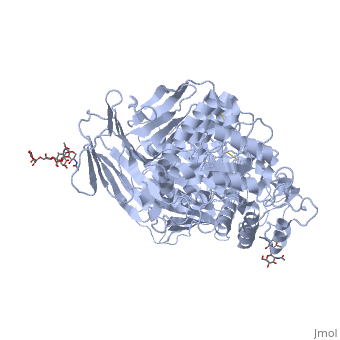Sandbox Surcrase isomaltase
From Proteopedia
| Line 26: | Line 26: | ||
'''Q1098P''' causes intracellular accumulation of mannose-rich SI in the Golgi | '''Q1098P''' causes intracellular accumulation of mannose-rich SI in the Golgi | ||
| - | + | '''C1229Y/F1745C''' cause sucrase domain membrane blockage (folding unaffected) | |
== Structural highlights == | == Structural highlights == | ||
Revision as of 18:24, 27 April 2016
|
Contents |
Structure
Sucrase isomaltase is composed of two subunits: . These two subunits come from a polypeptide, having an . Via heterodimerization, the sucrase isomaltase complex is formed [1]. The protein becomes glycosylated to attach to the apical membrane. [2] The N-terminus side of the isomaltase subunit anchors the protein to the cell membrane via hydrophobic interactions. [3]
Function
Sucrase isomaltase is a partially embedded integral protein located in the brush border of the small intestine. SI is responsible for catalyzing the hydrolysis of dietary carbohydrates that includes starch, sucrose, and isomaltase. The brush border is an important function of absorption of minerals and amino acids the body can use. The border is composed of millions of microvilli tightly packed together that are anywhere from 100 to 2,000 nanometers. Some other key enzymes in the small intestine are glucoamylase (Maltase), lactase, and peptidases. Most importantly, SI is involved in the final stage of carbohydrate digestion. [4]
Medical Implications
Congenital Sucrase-isomaltase Deficiency is a mutation in the sucrase isomaltase gene and it affects individuals ability to digest sugars such as sucrose and maltose. These sugars are found in fruits, table sugars, and grains such as bread and certain cereals. Congenital Sucrase-isomaltase Deficiency is an autosomally recessive intestinal disorder. Mutations cause the enzyme activity to be greatly reduced or completely absent. Symptoms of SID include diarrhea, abdominal pain, and cramps when sugar is ingested. [5]
Some known mutations that cause the disease:
Missorts the enzyme to the basolateral membrane
causes the SI unit to not be anchored to the membrane
L620P the SI unit accumulates predominantly in the Endoplasmic reticulum
Q1098P causes intracellular accumulation of mannose-rich SI in the Golgi
C1229Y/F1745C cause sucrase domain membrane blockage (folding unaffected)
Structural highlights
Sucrase-isomaltase is a monomer that is dependent upon experimental conditions in terms of structure. The four monomers form the asymmetric unit and have identical active sites. The active sites are composed of a shallow-substrate . The non-reducing end of substrates binds to a pocket. The sugar component has interactions with the inner subset, and the reduced component interacts with the superficial subsite. [6] The gene on which SI processes occur is located on chromosome 3 and is composed of 48 exons.
References
- ↑ "SI sucrase-isomaltase (alpha-glucosidase) [Homo sapiens (human)] - Gene - NCBI"
- ↑ Naim HY, Sterchi EE, Lentze MJ (1988). "Biosynthesis of the human sucrase-isomaltase complex. Differential O-glycosylation of the sucrase subunit correlates with its position within the enzyme complex". J. Biol. Chem. 263 (15): 7242–53. PMID 3366777
- ↑ http://www.jbc.org/content/254/6/1821.full.pdf
- ↑ http://www.uniprot.org/uniprot/P14410
- ↑ http://www.iffgd.org/site/gi-disorders/other/csid
- ↑ Sim L, Willemsma C, Mohan S, Naim HY, Pinto BM, Rose DR (2010). "Structural basis for substrate selectivity in human maltase-glucoamylase and sucrase-isomaltase N-terminal domains". J. Biol. Chem. 285 (23): 17763–70. doi:10.1074/jbc.M109.078980. PMC 2878540. PMID 20356844

